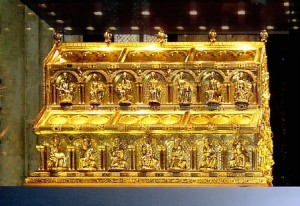St. Helena is one of the most important figures in the history of the early church. The mother of the emperor Constantine and an early Christian, she was pivotal in influencing her son in legalizing the practice of Christianity in the Roman Empire in the 4th century. During the 320s, Constantine commissioned his mother Helena to travel to the Holy Land to identify Biblical sites (where new churches would be built) and relics (which would be brought back to Rome).
Helena’s journey, considered by some to be the first true Christian pilgrimage, looms large in the history of the Church. She founded many of the world’s most sacred churches, and started the craze of the veneration of sacred objects that more than a thousand years later would lead to the Protestant Reformation. Among the many objects that Helena brought back to Europe, most have since been dismissed as forgeries, some are still debated, and one or two are believed to be true. Here are seven of her most famous discoveries.
True Cross – Liebana, Spain (and many other locations)
There is no object more closely associated with Helena than the True Cross. One of the main reasons for her pilgrimage was to recover the cross upon which Jesus had been crucified. As the story goes, three crosses were discovered buried beneath a pagan temple which the empress had ordered demolished. It was assumed that these were the crosses of Jesus and the two thieves. She identified the True Cross by using it to heal a direly sick woman. The Cross was subsequently brought back to Europe as a prize of the early church.
Once in Europe, accounts of the cross began to spread, and diverge, like wild fire. Countless pieces and splinters began showing up all over the continent. Many of these came from Helena’s True Cross, the largest piece of which is kept at the Monastery of Santo Toribio de Liebana in Spain. The great majority, however, were forgeries (many made from wood that does not even exist in the Holy Land).
While Helena’s cross probably did come from Jerusalem, and while it almost certainly was a real cross in the sense that it was used for executions, there would have been hundreds, if not thousands of such crosses in Judea. Most of these would have been used for firewood after too many uses. Based on this it is highly unlikely that Helena’s True Cross was the actual cross from the crucifixion of Jesus of Nazareth. Verdict: Highly Unlikely
Title of the Cross – Rome, Italy
The Titulus Crucis, or Title of the Cross, is the wooden plaque upon which was inscribed the letters INRI, a Latin acronym referring to Jesus the Nazarene, King of the Jews. It is one of the relics brought back with Helena from Jerusalem (it is not known if it was discovered at the same time as the True Cross). Unlike the Truss Cross, which was ultimately broken up and dispersed throughout Christendom, the Titulus Crucis was kept intact.
The Title of the Cross has been kept in the Church of Santa Croce in Rome since the 4th century. It was extensively studied and dated in the 1990s, and amazingly, it has been dated to the Roman era, with a majority opinion that it is, in fact, a 1st century relic. While the True Cross itself is dubitable, it is not unlikely that a follower of Jesus grabbed the much smaller and more easily identifiable Title of the Cross right after the Crucifixion. Verdict: Possible
Nails of the Crucifixion – Rome, Italy (and other locations)
The Nails of the Crucifixion, or Holy Nails, were apparently discovered at the same time as the True Cross. It is unknown how many nails were found (scholars and theologians can’t even decide how many were used, though the consensus seems to be either three or four), but a large number have turned up all over Europe.
One of the nails, or at least part of one, is kept in the Church of Santa Croce in Rome. Others claim to have been incorporated into the helmet and bridle of Constantine; the crown of Lombardy; the Spear of Destiny. One account indicated two of the three nails were tossed into the Mediterranean Sea. Even if any of the nails can be verified as those brought back with Helena, it is even less likely than the True Cross that any of these nails are authentic. Verdict: Virtually Impossible
Crown of Thorns – Paris, France (and many other locations)
The Crown of Thorns is another of Helena’s pilgrimage discoveries. But even by the standards of the questionable accounts of her journeys, the story of the acquisition of the Crown of Thorns is sketchy and almost non-existent. Like the other holy objects, the Crown of Thorns returned with Helena to Europe. There it was broken up and scattered to the four winds.
The largest piece wound up in the Cathedral of Notre Dame de Paris (the piece there is claimed to be almost the entire crown intact). However, there are dozens, if not hundreds, of thorns from the crown scattered among churches around the world. There is absolutely no way to know if any of these pieces came from Helena’s original. However, it is virtually impossible that the original crown would have survived the three centuries after the crucifixion without disintegrating, making Helena’s discovery highly questionable. Verdict: Virtually Impossible
Holy Tunic – Trier, Germany
The Seamless Robe of Jesus, or Holy Tunic, is believed to be the robe that Jesus wore on his last day, which was stripped from him before he was tortured, and for which Roman soldiers cast lots. Brought back to Europe by Helena, it is one of the few relics that ended up not in Rome, but rather in Trier, which then was one of the capitals of the Western Roman Empire. It is kept in the Cathedral of Trier, one of the oldest churches in the world.
Of all the relics identified by Helena, this is hands down the most improbable. Since it became the possession of a Roman soldier, there is virtually no way that it would ever have come to be kept by followers of Jesus. Furthermore, there is virtually no specific information available of how the robe came into Helena’s possession. Finally, because of the way it has been treated for preservation, it is impossible to carbon date the robe. Based on this information, there is almost no way that this was the Holy Tunic. Verdict: Impossible
Holy Stairs – Rome, Italy
The Scala Sancta, or Holy Stairs, is a marble staircase that is located in Rome. Originally located in Jerusalem, it is believed that they were the steps that led to the palace of Pontius Pilate, and that Jesus climbed these stairs (possibly on his knees) on his way to be tried by the Roman Governor. Having survived the various destructions of Jerusalem, Helena removed the staircase and brought it back with her to Rome.
The stairs were then installed near the Basilica of St. John in Lateran, where they have been climbed by pilgrims to Rome for nearly seventeen centuries. Even though Jerusalem was largely in ruins by the 4th century, it is highly likely that the local authorities still knew exactly where the old Roman palace had stood. Therefore, the possibility that these stairs were originally part of the palace is very high, and the possibility that they were climbed by Jesus of Nazareth is similarly very high. Verdict: Highly Likely
Relics of the Three Wise Men – Cologne, Germany
Okay, this one is arguably the largest stretch of all. Among the antiquities brought back with Helena were the relics of the Three Wise Men. For a few years the bodies were kept at Constantinople, then moved to Milan, and ultimately to Cologne. The relics still reside in the Shrine of the Three Kings, an immense golden reliquary, in Cologne Cathedral in Germany.
This has been controversial even since medieval times. Considering that a) we don’t know how many wise men there actually were, b) where they were from, c) where they died, and that not even the Bible talks about these things, this one is simply not true. Whoever is buried in the Shrine of the Three Kings, they had nothing to do with the birth of Jesus. Verdict: Impossible


you need to read the travels of marco polo/ book 1 /chapter 13 and 14 might change your way of thinking but looks like you have already made the call
Do you mean the book that he wrote?
Dear Brother Kramer,
Some things get more interesting the more you learn about them, but impalement is not like that. For the sake of your casual readers, I will describe that mode of execution, though I don’t like to. There are variations, of course, but in the case of Jesus there were both pale and scaffold. Following installment of the pale, with the hands and feet nailed in place, the victim could lift himself just enough to prevent the pale from driving fully upward into the body. But the damage was accomplished early on, for the bowel was destroyed first. Then, as exhaustion set in, that little tree trunk would impinge upon the diaphragm, impairing breathing.
We may gain further insight into these events by recalling how the thieves on either side of Jesus were still alive at around 4pm that Saturday afternoon, and how breaking their legs induced a quick death. They died by suffocation. But the Lord was already dead. They stuck him with a spear, just to make sure, which released the massive abdominal edema we have all read about.
Nobody gets over impalement. Nobody survives the destruction of the bowel. Anyone who might suggest that Christ merely “swooned” and later came to doesn’t understand the process. Crucifixion is but a euphemism for impalement. Ain’t no such thing as crucifixion, like we see in the movies and in western art. But here is a proof that the Savior was well and truly dead when they put him into the tomb (forgive the circular reasoning), because only a dead man can truly come.back to life.
Here endeth the lesson.
Interesting. Gruesome, but interesting.
Dear Brother Kramer,
I don’t blame St Helena for any of this crap. Rather, I blame the greasy people who wrote about her, people like Eusebius Pamphilius, for twisting the parts that might have been true and making up the rest. For there is a false premise that Jesus died by crucifixion, which is a true trope and a euphemism for impalement. For Christ was indeed impaled, and we have a picture of that event in the little stick drawing called the Chi Rho. The quest for the True Cross then becomes a quest for true information; Constantine obviously favored the Chi Rho to the tau cross, but his mother was not so sure. She just wanted to know the truth. I hope she found that truth. But there is no record of her having done so, none at all, unless you count the fake news published by her demented chaplain.
Here endeth the lesson.
Never heard any of that before. Interesting.